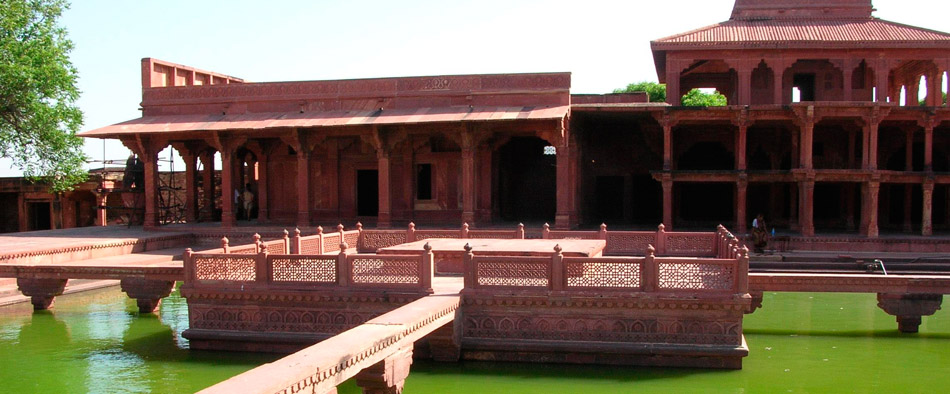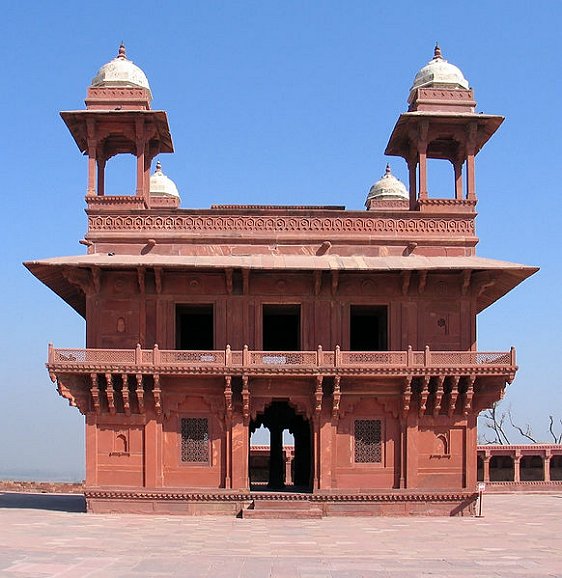Fatehpur Sikri is a city 37 kms west of Agra. It was planned as a great town by Mughal emperor Akbar with great planning and care in honor of Sheikh Salim Chist (a sufi saint who blessed Akbar with his first son and heir who was named Salim and later called as Jahangir) but had to abandon it just after 15 years due to scarcity of water in the town. This town was first named Sikrigarh and was constructed by Sikriwal Rajas Rajput last Emperor Maharana Sangram Singh in 1500. Also archaeologists found ruins of a temple dating back to 12th century suggesting the reign of Rajputs in the area long before the Mughals took over the area.
Places you must see:
Buland Darwaza is the largest of gateways in the world also known as 'The Gate of Magnificence' built by Emperor Akbar in 1601 A.D to commemorate his victory over Gujarat.It is made up of red and buff sandstone and decorated by carvings and inlays of white and black marble.

Jama Masjid (Fatehpur Sikri) is a mosque which was completed under the supervision of Saint Chisti and his descendants in 1571. Buland Darwaza and the Tomb of Salim Chisti are the part of this Mosque complex.The five Chhatris and the central Mihrab are adorned with an inlaid mosaic of stones that are bordered with glazed tiles and has golden inscriptions on royal blue background.

Tomb of Salim Chisti was originally built with red sandstone but later converted into a beautiful marble mausoleum which was commenced in 1571 and was completed 15 years later.It is believed that by offering prayers at this Mazar, whatever one wishes will definitely get fulfilled.

Diwan-I- Aam or the hall of public audience is a huge rectangular walled-in courtyard where petitions were heard, proclamations were made and entertainment programs were held and the emperor Akbar interacted with his subjects on one on one basis.In front of a royal seat, a stone hook is still found embedded in the ground.As per tradition, Akbar's pet elephant Hiran was tied to this hook to crush the head of the guilty. If it refused to obey thrice, the victim was freed.

Diwan-I-Khas or the hall of private audience is a plain square building with a huge and richly carved pillar in the center.Akbar and representatives of different religions used to discuss their faiths.

Ibadat Khana or the House of worship was built in 1575 C.E by the Mughal emperor Akbar at his palace, to gather religious leaders of many faiths in discussion.

Pachisi Court is a pavilion close to Diwan-I-Aam. The paving of this courtyard has been set in black and white, like a gigantic game board, on which the game Pachisi (much like Chess) was played.The interesting part of Pachisi is that the game was played with humans as chessmen.

Panch Mahal also called as Badgir or wind tower is a five floored pillared pavilion was built by emperor Akbar. This extra ordinary building was constructed to alleviate the heat.The first floor has 84 pillars, the second floor has 56 pillars, the third floor has 20 pillars and the fourth one has 12 pillars and the top of the building is decorated by beautiful square chhatri with a cupola.

Birbal's house is a house of Akbar's favorite minister Birbal, who was a Hindu.It is one of the marvelous buildings of Imperial Harem.Striking feature of this building is the horizontal sloping sunshades or chhajas and the brackets which supports them.

Jodha Bai's Palace is an excellent example of the fusion of Hindu and Mughal architecture.After Akbar conquered Malwa, he faced strong resistances from the Rajput kings. Akbar dealt with this problem diplomatically, allowing them to keep their kingdoms and getting into marriage alliances with the princesses of the Rajput clan.He married Jodha Bai, sister of Man Singh, the powerful ruler of Jaipur.She was Akbar's favorite queen and was allowed to worship in the Hindu way in her palace.

Fatehpur Sikri Palace complex was built by Mughal emperor Akbar, is situated on the ridge of a hill by the side of an artificial lake.The construction of the palacial complex began in 1572. This palace complex consists of all the above sites.

No comments:
Post a Comment